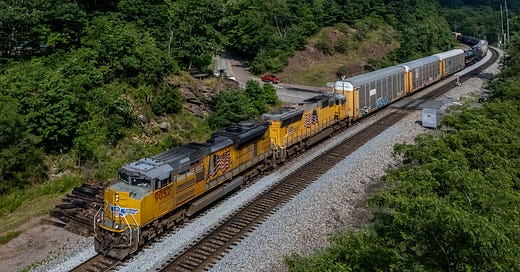courtesy: Steel Wheels Photography
Inside This Issue
· Here I Go Again: UP Replicates Last Year’s Strong Q1 Results
· Can’t Stop the Healing: NS Continues Down Path of Recovery
· Tariff Backoff? White House Signals De-Escalation with China. Sort Of. Maybe.
· Big Threat but Little Rot Yet: RRs Say Demand Still Holding in April
· Sudden Zeal for Autos and Steel? Encouraging Words from CSX
· Nothing on Ships, Nothing in Shops: Will Tariff War Cause Consumer Shortages?
· Furloughs if Demand Slows? RRs Sticking to Current Staffing… For Now
· In Economic Stall, Would Prices Rise or Fall? The Fed Debates: Lower Rates?
· This Week: Q1 Results from CN, CPKC, and BNSF
Please kindly refrain from sharing and forwarding Railroad Weekly. Discounts are available for companies with multiple readers. Please email jay@railroadweekly.com for more info. Thanks for your cooperation!
Track Talk
“We felt really good last week. We felt pretty bad yesterday. Today, we feel a little more encouraged… there’s no way to predict where we go right now. We’re in a really uncertain spot. But we haven’t seen negative trends yet that really alarm us or cause us to do anything. That said, we’re scenario planning… stay tuned.”
-Norfolk Southern CEO Mark George
The Latest
· De-escalation? Financial markets rallied last week as President Trump stepped back from his threats to fire Fed chief Jay Powell, and he and his team telegraphed some measure of retreat from the trade spat with China. Treasury Secretary Scott Bessent calmed nerves by saying a “break between the two countries in trade does not suit anyone’s interest.”
· Nevertheless, the economy’s anxiety level remains high—extremely high, judging from corporate earnings calls, business sentiment surveys, and measures of consumer confidence. The policy uncertainty is starting to show in hard data too, i.e., last week’s steep drop in existing home sales (see Economy section below). Leisure travel is already feeling a slowdown as price-sensitive consumers book fewer hotels and airline tickets. Most relevantly for railroads—and ominously for American consumers—container ship departures from Asia to California are down sharply, heralding a steep decline in intermodal traffic and a potential spike in consumer prices (and even product shortages) later this summer. As of now, Washington’s three-month pause on “reciprocal” tariffs will end in early July. That’s separate from service fees on Chinese-built ships scheduled to take effect in October. Policies, however, are changing by the week.
· Fortunately, the U.S. economy stood on strong ground going into this new period of tariff disorder. As a result, most companies reporting their first quarter results still say that business conditions are generally strong. That’s even true for heavily exposed firms like airlines, which say demand for premium tickets and international travel remains robust. Airlines, like much of the U.S. economy, are also thrilled to see oil prices sharply down. Another critical pillar of the economy’s resilience—and of consumer spending—is the job market, showing no signs yet of major distress. Stay tuned this Friday (May 2nd), when the U.S. Labor Department publishes its employment report for April.
· Two areas of the economy feeling most uneasy right now are 1) small businesses, many of which have products or inputs sourced from China, and without the lobbying power of giants like Walmart, and 2) the transportation and logistics sector, dependent on global supply chains now breaking as tariffs reconfigure trade flows. Here’s the trucking firm Saia last week: “We see what our customers are telling us.... They’re uncertain. They’re making decisions based on a very short-term sort of focus.” And here’s an anonymous manufacturer, quoted in a new Kansas City Fed survey: “Lots of supply chain uncertainty. Placing an order with two-month lead time means we have no idea what tariffs will be in place when the goods arrive in port. It makes business planning and pricing almost impossible.”
· Concerns are greater still for companies and consumers in Canada and Mexico. But interestingly, Mexico’s stock market is jumping (see the Market Indicator chart below) amid optimism about the country’s ability to be a relative winner in the current trade war. Sure enough, Mexico is still ploughing full speed ahead with a major expansion of its largest container port in Manzanillo.
· And what about railroads? Another two Class Is reported their Q1 earnings last week. As you’ll read in greater detail below, Union Pacific and Norfolk Southern—like CSX a week earlier—joined the chorus of companies citing uncertainty about the months and quarters to come. But also like other companies, they said business in Q1 was pretty strong, and not too much has changed thus far in April. Their intermodal
Keep reading with a 7-day free trial
Subscribe to Railroad Weekly to keep reading this post and get 7 days of free access to the full post archives.




